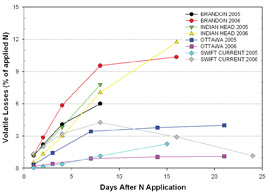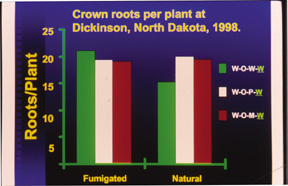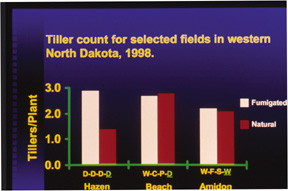
Features
Agronomy
Cereals
How growing pulse crops boosts yield potential of the next crop
Insights into 'rotational benefit' contribution of pulse crops.
November 27, 2007 By John Harapiak
The benefits of maintaining and improving soil productivity as a result of
diversifying cropping rotations is pretty much an accepted fact within western
Canada. Diversifying crop rotations also results in improved yields. Utilizing
this concept is a cropping strategy that pays dividends now, as well as in the
future.
| Figure 1. Impact of soil fumigation on crop canopy at the tillering stage of growth in a field in continuous durum wheat production. |
 |
Wheat-on-wheat creates yield loss
Researchers have demonstrated that wheat yields on wheat stubble have been lower
than when grown on most other types of stubble. This observation is probably
explained by increased disease pressure and the fact that wheat is more efficient
at extracting soil moisture than most other prairie crops.
Canola rotation benefits wheat yield
Based on Alberta data, within the Black, Gray-Black and the Gray soil zones,
growing wheat on canola stubble instead of on wheat stubble can boost wheat
yields by about 20 percent. Surprisingly, the yield boost of wheat that results
from switching from wheat to barley stubble is often as great as the benefit
attributed to canola stubble, although the presence of volunteer barley in wheat
would lower both grade and realized price.
Benefits may decline in the drier regions
Within the Thin Black, Dark Brown and Brown soil zones, the yield benefit of
growing wheat on either canola or barley stubble appears to be less (zero to
10 percent). The reduced benefit resulting from crop rotation in the drier regions
is most likely related to the over-riding impact of more frequent moisture limitations
on yield potential in these areas.
Impact of canola vs. pulse stubble on cereal yields
While good data is difficult to locate, it appears that in the wetter regions,
the rotational yield benefit of growing wheat on field pea stubble rather than
wheat stubble can range between 20 to 30 percent. The additional 'pulse effect'
benefit for growing wheat on field pea stubble is at least partially, but not
wholly, associated with the higher amounts of nitrogen released to the following
crop from decomposing pulse crop residues.
| Figure 2. Impact of fumigation on improving crown root development was greatest in a wheat-oats-wheat-wheat rotation. A two year break in the wheat rotation sufficiently reduced root disease pressure, so as to effectively negate any benefit that could be attributed to fumigation. |
 |
Researchers struggle to define 'rotational benefits'
Although the yield benefits associated with rotating crops are a given, the
inherent cause of the yield benefits have not been well defined. As a result,
these yield advantages are ascribed to a poorly defined term called 'rotational
benefits'. This is a concept that includes a wide range of potential contributing
factors such as reduced disease pressure, variations in crop rooting depth,
more residual soil water, improved soil tilth, more favourable soil biological
activity, more rapid release of N from crop residues, reduced risk of herbicide
carryover damage and so on. The use of this vague term results from the fact
that researchers found it difficult to quantify or predict the cause of the
yield gain.
Fumigation used to evaluate disease pressure
While the specific causes of the rotational yield benefits have been difficult
to define, field demonstrations carried out in North Dakota are lending strong
support to the idea that disease suppression may in fact be the major contributor
to these yield gains. In these trials, non-destructive soil fumigation was used
as a means of assessing the effectiveness of crop rotations for reducing root
disease pressure. Any differences that were observed between the fumigated and
non-fumigated treatments were assumed to be due to differences in damage resulting
from root diseases.
Fumigation suppresses harmful organisms
As illustrated in the photo, fumigation was conducted under a heavy plastic
cover that was trenched into the soil along the edge of the plot area. The fumigant,
methyl bromide, was allowed to seep into the soil over a period of two days.
This fumigant has been used to control soilborne diseases in high value specialty
crops. However, the cost is prohibitive for use in field crops. The impact of
fumigation on a durum on durum stand in terms of density and vigour was quite
striking (see Figure 1).
Impact of crop sequencing on crown roots
If root disease pressure is severe, large differences in plant growth characteristics
can occur. If root disease pressure is minimal, there should be little difference
between the fumigated and non-fumigated plots. In that regard, the data collected
indicates there was a very significant impact of the previous crop on root disease
pressure of durum on HRS wheat. In Figure 2, it is obvious that the greatest
positive benefit of fumigation on crown root development existed in a wheat-oats-wheat-wheat
rotation. There was minimal impact of fumigation if the preceding crop was field
peas or millet rather than wheat.
| Figure 3. The significant benefit in early season wheat tiller production that resulted from soil fumigation in a continuous wheat rotation was virtually eliminated by introducing a two year, non-host crop break (i.e. corn-peas or fallow-soybeans) into the wheat rotation. Similar trends were observed in wheat head density measurements and yield results. |
 |
Similar trends in durum rotations
As illustrated in Figure 3, the greatest benefit resulting from fumigation on
tiller development existed in fields that were in a continuous wheat-durum rotation.
However, if the preceding two crops were either corn-peas or fallow-soybeans,
the benefit of fumigation was minimal. It is obvious that a two year break in
wheat-durum production (i.e. planted to a non-host crops) was sufficient to
negate any benefit from fumigation. Wheat-durum yields were increased by as
much as 30 to 50 percent as a result of fumigation where root disease pressure
was high.
Role of N in the 'rotational benefit' of pulse crops
The impact on wheat yields on the extra N released by a previous pulse crop
is much less than anticipated. In fact, some researchers now suggest that as
much as 80 to 90 percent of the 'rotational benefit' that results from incorporating
pulse crops into a wheat rotation can be attributed to factors other than N.
The North Dakota fumigation trials suggest the suppression of soilborne disease
organisms that result from the introduction of non-host crops into a crop rotation
are a greater contributor to the 'rotational benefit' yield boosts that have
been observed, rather than the N-related, so-called 'pulse effect'.
John Harapiak has approximately 40 years of western
Canadian based fertilizer related experience. He will continue to contribute
stories to Top Crop Manager. He can be contacted by e-mail at: jharapiak@shaw.ca.